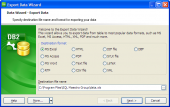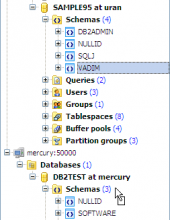DB2 Maestro online Help
| Prev | Return to chapter overview | Next |
Editing tablespace properties
Tablespace Editor provides you with an ability to edit tablespaces.
Type (LARGE, REGULAR, SYSTEM TEMPORARY, or USER TEMPORARY)
Specifies the type of table space that is to be created. If no type is specified, the default is determined by the MANAGED BY clause.
Database partition group
Specifies the database partition group for the table space. The database partition group must exist.
Page size
Defines the size of pages used for the table space. The valid values for integer without the suffix K are 4 096, 8 192, 16 384, or 32 768. The valid values for integer with the suffix K are 4, 8, 16, or 32. Any number of spaces is allowed between integer and K, including no space.
Managed by (SYSTEM,DATABASE)
SYSTEM specifies that the table space is to be an SMS table space. When the type of table space is not specified, the default behavior is to create a regular table space.
DATABASE specifies that the table space is to be a DMS table space. When the type of table space is not specified, the default behavior is to create a large table space.
Extent size
Specifies the number of pages that will be written to a container before skipping to the next container. The extent size value can also be specified as an integer value followed by K (for kilobytes) or M (for megabytes). If specified in this way, the floor of the number of bytes divided by the page size is used to determine the value for the extent size. The database manager cycles repeatedly through the containers as data is stored.
Prefetch size
Specifies to read in data needed by a query prior to it being referenced by the query, so that the query need not wait for I/O to be performed.
Buffer pool name
The name of the buffer pool used for tables in this table space.
Overhead
Specifies the I/O controller overhead and disk seek and latency time. This value is used to determine the cost of I/O during query optimization.
Transferrate
Specifies the time to read one page into memory. This value is used to determine the cost of I/O during query optimization.
Drop recovery
Indicates whether dropped tables in the specified table space can be recovered.
To apply the changes, select the Apply Changes item in the Navigation bar or use Ctrl+F9 or Ctrl+F7 shortcut keys.
It is also possible to modify object properties without opening the object editor: use the Object Properties item of the popup menu of the selected object from the explorer tree.
| Prev | Return to chapter overview | Next |





 Download
Download Buy
Buy
